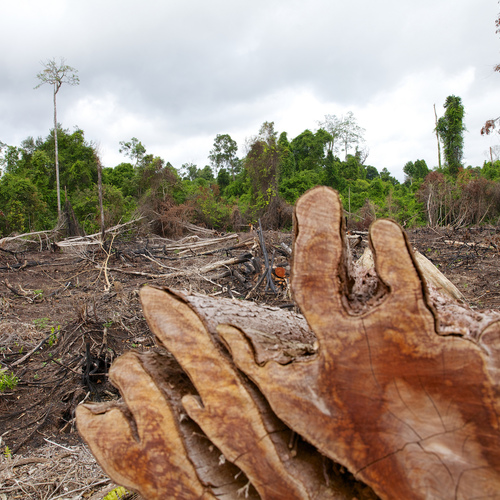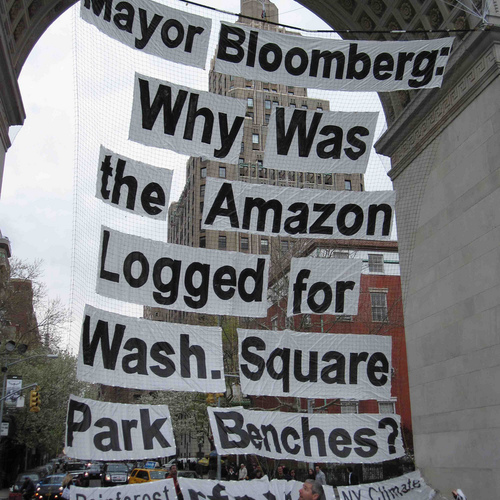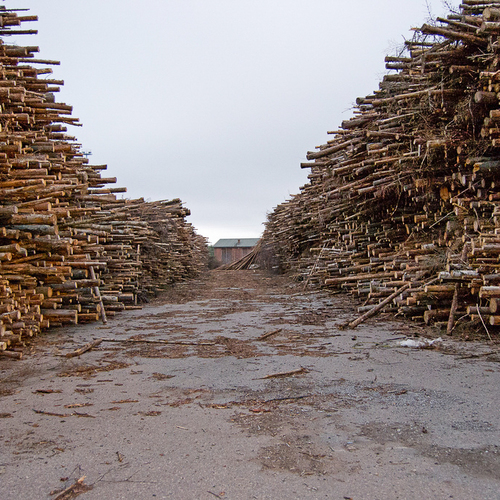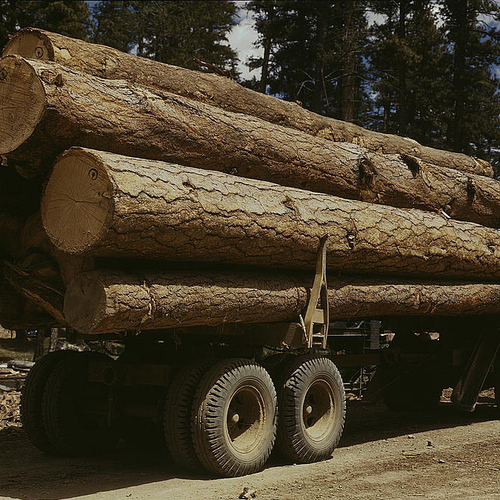
Are you a green builder? If so, you probably care about where your lumber comes from. That said, most green builders don’t care enough about where their lumber comes from to change their buying habits.
Caring about where our lumber (or food) comes from makes life complicated, expensive, and in some cases depressing. The sad fact is that global capitalism allows the rapacious seizure of our planet’s resources, and many industries, including fishing, forestry, and mining, are coming up against limits to the earth’s ability to tolerate our depredations. While that may not be obvious when you’re loading 2x4s onto your cart at Home Depot, it’s true. It’s time to change our behavior.
I live in the woods. Every year, I cut down a few trees. Some are used for firewood; some have been used to make tool handles or furniture; and some to transform into lumber for buildings I’ve raised. I live on a parcel of 30 acres, and have been cutting trees here for over 49 years. When I moved here, many sections of the parcel had small-diameter trees. These woods now resemble a mature forest, with a healthy mixture of impressive sugar maple, red maple, ash, white birch, yellow birch, cherry, poplar, apple, hop hornbeam, spruce, balsam fir, and cedar.
While many of the world’s forest parcels are healthy, the global perspective is rather bleak. According to one source, the planet is losing 32 million acres of forest annually—about 60 acres per minute.
Different approaches to forestry
Most foresters are trained professionals with university degrees; I’m certainly not a forester. Some logging practices endorsed by foresters—including limited clearcuts in certain ecosystems—look bad to untrained observers, but mimic natural events that contribute to a healthy forest. So casual observers need to be…
Weekly Newsletter
Get building science and energy efficiency advice, plus special offers, in your inbox.

This article is only available to GBA Prime Members
Sign up for a free trial and get instant access to this article as well as GBA’s complete library of premium articles and construction details.
Start Free TrialAlready a member? Log in















12 Comments
So much in here, one of your longer pieces I think, and yet the one word cut through everything else for me.
The word has been increasingly bouncing around in my head for years now. It's the one I've watched so many concerned and well meaning people working on clean energy and climate issues desperately try to avoid.
It's the word that's difficult talk about without being accused of shaming people, virtue signaling, wanting to harm the poor, or take away freedom.
I dare say the next great revelation that saves humankind may not be some great technological advancement, but figuring out how to progress, learn, build, and live happier healthier lives by having...
Restraint
Thanks for this Martin
Great comment, I've been mulling over these things for years as well. Took the sentiment right out of my head and put it down on paper, errr screen, much better than I could have.
Classic photo Martin. Looks like a kerf and adze approach. I've used that technique for backcountry bridge stringers. I later got a 94cc chainsaw and went the Alaskan mill route. Both are hard work, one is louder. My understanding is that, traditionally, adzing was a finishing tool used after a broad axe did the initial hewing.
The juxtaposition of this piece with Fernando's "How Lumber is Manufactured" is quite interesting. I appreciate the points you've made here. We should see and appreciate the multitude of values a forest offers besides lumber. These other values are not just emotional; they carry real economic value. I tend to think the ultimate failure is in our economic accounting and our inability/unwillingness to properly value ecological systems. We seldom account for the externalities of destroying or degrading them.
Of course we will continue to build structures, and so there will always be the question of the best way to proceed. Aka finding balance. Restraint certainly needs to play a large role in finding this balance. I tend to think innovation (of sorts) will also need to play a pivotal role. I have roughly zero faith that all of Earth's societies will collectively show enough restraint to stem the oncoming tide. If we could, it would probably be the easier path. I suspect we need the intervention of some significant innovation however. Solar PV is one example of such an innovation I suppose (but not the only one needed). And likewise, we will need to continue living with imperfect solutions. I know we can manage forests (even sometimes quite intensively) in a way that doesn't undermine all the 'other' values while also generating useful wood products. What I wonder is whether we can do away altogether with the industrialized plantation style management outlined in Fernando's piece while still producing the needed commodity lumber. We can certainly do better in many cases at the least.
Maine Tyler,
Yes, the kerf and adze approach. Before kerfing, I snapped two lines lengthways on the side of the log to act as guides for the depths of the kerfs. These snapped lines connected two level lines (marked with a pencil and level) made on the log ends.
I bought a broad ax and experimented with it. I found it hard to control, and I never got the hang of it. So I just used a bow saw to make the kerfs and flattened the logs with an adze.
Like you, I bought an Alaskan mill. I used the Alaskan mill to make 2-inch thick maple planks. After two years of air drying, the maple planks became my dining room table.
The log shown in the photo is still part of my house, above my head as I write these words. The dining room table I made still gets daily use.
Thanks for your comments.
Martin-- like you, we're in Vermont with ready access to local lumber from local sawmills. In my (limited!) experience, the biggest challenge we encountered in trying to use local lumber was that it came rough-sawn. As such, it was largely incompatible with the expected dimensions of commercial 2x lumber and associated systems (e.g., interior stud wall width; the Simpson metal connector ecosystem). Few framers wanted to deal with the hassle.
We ended up using local lumber in a couple areas of the build, but nothing like what I'd imagined we might be able to.
karlb,
Was the lumber custom cut for you? I have three mills within a few minutes drive that will all cut to whatever dimensions I request. The complication here is making sure it is grade stamped.
Karl,
Yes, there are hassles with using rough-sawn lumber. If it is used green, it will shrink or (sometimes) twist. If you need to dry it first, that's a lot of labor, involving stickering and covering the piles with old metal roofing and waiting.
That said, plenty of people have done it. It makes the most sense for owner-builders with little money and lots of time.
Martin and Malcolm, good points. At least one of our local mills does do custom sawing and planing (the other may simply have not wanted to deal with the relatively small quantities that our order entailed). As a renovation of an old house, our local material usage ended up being
- rough-sawn 2x10s throughout the basement to sister existing joists
- "half"-planed 2x8 T&G as a 2nd floor subfloor to span the tie-beams
- misc rough-sawn 1x material to patch in boards for the old roof deck, etc.
Loads of conventional 2x material, TJIs, and plywood elsewhere though.
karlb,
Sounds like a sensible trade off.
Today I spent over $600 at the lumberyard on a shockingly small amount of KD fir 2"x3"s for some cabinetry. I could probably have shaved several hundred off that getting it from a mill, and having it kiln dried locally, but the effort involved just wasn't worth it.
A disturbing new analysis of carbon storage and carbon releases associated with forests in Canada was discussed in a recent New York Times article: "Beginning in the early 2000s, twice as much carbon-absorbing ability was destroyed through logging [in Canada] as was regenerated by replanting. In the decades since, the forest has largely stopped regenerating at all. In the 1990s Canadian forests were sequestering 165 million tons of carbon each year, 20 million more than the carbon-storage loss by logging. In the 2010s those same forests released 35 million more tons of carbon each year than they stored, not including the additional carbon released by logging. In the 2020s, that number has grown to 180 million tons released annually."
The article notes that more carbon is released annually in wildfires than is sequestered annually by forest growth.
And here's another thought-provoking article from the New York Times:
"In the early 1990s, I worked as a tree planter in northern Ontario. .... I was driven in part by the idealistic view that planting a tree was always going to be better than not planting one. In retrospect, this wasn’t true. Forestry experts understand that a monoculture of trees — like the black spruce saplings we were planting, six feet apart in neat rows — has made wildfires more likely and much worse when they occur. ... There is a difference between replanting trees to replenish an area and doing what I had done: plant a monoculture of black spruce. Despite my friend’s cheery exhortation at the low point of that summer, we weren’t making a forest. What I helped plant was more like a tree farm. "
This is an excellent video-told story of the Menominee people’s approach to forestry from the PBS America Outdoors: Understory Collection that gives inspired perspective. I believe this to be the crowd to appreciate it.
Log in or become a member to post a comment.
Sign up Log in